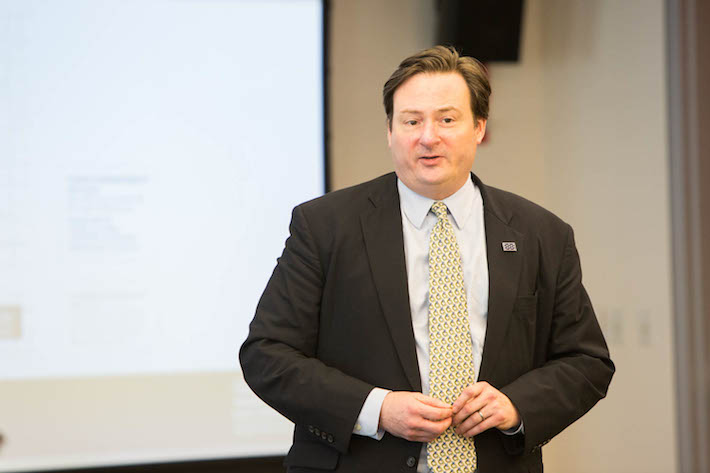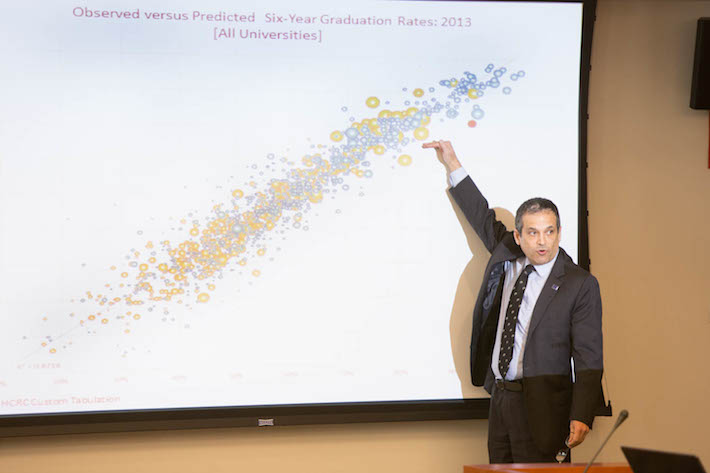The George Washington University’s six-year graduation rate—and other core indicators of academic excellence—paint a strong picture of the university’s academic future, Interim Provost Forrest Maltzman said at Friday’s Faculty Senate meeting.
“Our six-year graduation rate of 79.5 percent is much stronger than the vast majority of the nation,” he said. “But there is more progress to be made.”
Dr. Maltzman’s remarks highlighted a busy afternoon of reports at Friday’s senate meeting, which featured presentations from Senior Associate Provost for International Strategy Doug Shaw and Vice Provost for Enrollment Management and Retention Laurie Koehler.
In his presentation on core indicators of academic excellence, Dr. Maltzman called GW’s six-year graduation rate a “summary of everything that is occurring on this campus.”
“This is students voting about what is happening in terms of the food service, the housing system, financial aid allocation, what occurs in the classroom,” he said. “Everything that occurs in some respect is summarized by the graduation rate.”
He spoke of several other areas, including faculty composition and compensation. The university has made strides in the diversity of its faculty, Dr. Maltzman said. Minority faculty were 26 percent of the university’s tenured and tenure-track faculty in 2015, up from 16 percent in 2006.
“The progress we have made here is real, especially when you compare it to our market basket schools,” he said. “In 2005, we were right at the average for the market basket in terms of underrepresented population among the faculty at GW on the tenure track. In 2013, we were above the average in terms of underrepresented populations. Our proportion of female faculty compared to our market basket has been above the average and the gap is increasing.”
 Doug Shaw presented Friday on the university's international strategy. (Logan Werlinger/GW Today)
Doug Shaw presented Friday on the university's international strategy. (Logan Werlinger/GW Today)
International strategy
Dr. Shaw, who last summer was announced as the university’s first senior associate provost for international strategy, emphasized GW’s geographic proximity to global institutions in Washington, D.C., as a unique advantage.
“That proximity creates opportunity for alignment with the activities of the organizations, many of which are charged with responding to global human problems,” he said. “Where many universities see internationalization as only something that happens very far away, because of our location, we can make internationalization happen very effectively right here on campus.”
In a presentation similar to one he gave at the February meeting of the Board of Trustees, Dr. Shaw highlighted the powerful global institutions in the university’s backyard—including the U.S. Department of State, the International Monetary Fund and foreign embassies—as examples of partner organizations for the university.
He also cited GW foreign policy interests. Sean Murphy, the Patricia Roberts Harris Research Professor of Law, is running for reelection to the International Law Commission this year, Dr. Shaw said.
“That vote will be held at the general assembly in November, and U.S. Secretary of State John Kerry has hosted a reception for him in New York and is actively campaigning for him to be reelected,” Dr. Shaw said. “That election is important to the government of the United States, and I would argue it’s important to the George Washington University. We have some equities in these issues.”
In recent weeks, the university has hosted the German foreign minister, the transitional president of the Central African Republic and the French minister of the interior. Those visits often are part of larger partnerships, Dr. Shaw said. In December, a delegation of GW students attended the World Internet Conference in China, a trip that originated when Lu Wei, head of the Chinese Cyberspace Administration, visited campus a year earlier.
 Vice Provost for Enrollment Management and Retention Laurie Koehler discussed GW's enrollment efforts. (Logan Werlinger/GW Today)
Vice Provost for Enrollment Management and Retention Laurie Koehler discussed GW's enrollment efforts. (Logan Werlinger/GW Today)
Admissions update
Ms. Koehler provided a presentation on the university’s enrollment efforts.
“When I was hired, I was given the charge related to undergraduate admissions to really focus on two key areas: enhancing the academic quality and the diversity of our undergraduate student body,” she said. “Meeting these goals requires a stable and sustainable approach with no shortcuts or quick fixes. There are plenty of schools who have tried those but that’s not the direction we wanted to take.”
GW over the past few years has seen improvement in several enrollment areas, Ms. Koehler said, including the quality of its incoming classes. The median grade-point-average of incoming students has increased from a 3.5 in 2013 to a 3.64 in 2015. GW programs, including the launching of a partnership with the Posse Foundation and the creation of the GW District Scholars Award, also have enhanced GW’s admissions efforts.
“I’m very excited about the Posse program,” Ms. Koehler said. “These are students who nationally have a 90 percent graduation rate, which is higher than our graduation rate. They are pretty amazing kids.”
University admissions officials last month reported applications for first-year undergraduate students applying to enter for fall 2016 rose an unprecedented 28 percent over the previous year. In July, GW announced it will no longer require most undergraduate applicants to submit SAT or ACT test scores.
“The admission process remains a holistic one,” Ms. Koehler said. “There is a lot of information that cannot be captured on a transcript that we are looking at. We’re looking at how a student writes, the recommendations the student submits, we’re looking at their persistence, their ability to overcome challenges, their involvement in their school and community. All of these pieces are incorporated into that review.”


